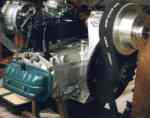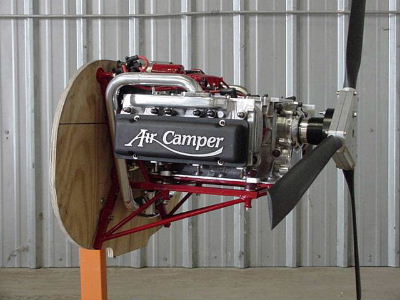

Continental Spin On Oil FilterWhen our engine was being overhauled by Hants Lightplane Services, Cliff Lovell recommended supplementing the standard oil filter screen device with a spin on oil filter. The units advertised in the commonly available parts catalogues are horribly expensive, but a simple and relatively inexpensive version is available and is known as the TAF filter. We bought ours from Sportplane Supplies, also of Wallingford by coincidence. Contact Jack Walters on tel 01491 838292. For no particular reason we haven't bought anything from Sportplane Supplies since 1997, but hopefully the telephone number is still good. If not, these filter assemblies are also advertised in Trade-a-Plane and are made by F&M CO, Borger, Texas. The filter assembly simply bolts on to the three studs in place of the normal blank which covers the oil cooler supply and return ports on the left hand side of the crankcase. Once the filter is fitted you have no ability to subsequently pipe in an oil cooler. The assembly uses readily available Champion 48108 filter cannisters. Reading from the Sportplane catalogue, TAF filter assemblies are FAA-PMA approved for C75-12, C85-12, C90-12, -14, -16 engines (STC SE7562SW) and O-200, O-200A engines (STC SE7559SW) |
0-200 Engine Mount bolts...We thought that other builders planning to use an O-200 or C-90-14 might benefit from a recent discovery we made regarding engine mounting bolts. We have a Continental 0-200 (Lord mounts) and the hardware catalogues state that AN6-55 bolts (drilled shank) are the standard ones to use. Unfortunately these are a fair bit too long. AN6-51 would appear to be better. However, we should warn that we haven't actually assembled our engine to the mounting frame yet, but we do have all the parts available. Of course you could fit spacers, but we would prefer to avoid the extra weight. The long bolts may be intentional to allow some scope for c.of g. adjustment, but we have noticed from Continental manuals and Tony Bingelis reference books that other O-200 installations don't seem to feature lots of spacers. However, they do seem to have much deeper tubes which the bolts pass through at the engine end of the engine mounting frame (see picture on page 31 of the book "Tony Bingelis on Engines"). As the bolts are expensive (approx. $8 each) it's best to buy the right ones the first time!. We therefore recommend that builders using an O-200 or C-90-14 check the required bolt length themselves, rather than order the standard type. Best Wishes, Chris and Fran PS Jim Wills' drawings don't claim that the engine mounting is suitable for use with an O-200 (reference to this engine was removed from drawing 047-004 sheet 1 on Issue A), but it seems to be fine, apart from the bolts being too long, as described above. |
THROTTLESHello Paul, Seeing your request for material on the web site home page prompted us to send you this. Twice recently we have come across the statement that light aircraft throttles should be arranged to spring open in the event that the cable breaks (see references below). We can see the sense of this in a situation where the cable breaks at low level when climbing away and you want to guarantee continued full throttle. However, we are concerned by this arrangement in the case of an aircraft that will always be hand propped. We've spoken to John Tempest of the PFA about it and he has confirmed that there is no mandatory requirement for having the throttle sprung open. However, we wondered what other builders were intending to do, or have done. Rather than throttle cable breakage, the hazard that is more likely to occur with a spring open throttle is throttle control friction slippage during the hand propping sequence. Clearly this could have serious consequences for the person hand propping and could even result in a run-away aircraft. The hazard to the person hand propping would be present at the start of every flight. Therefore the risk, which is a combination of the consequences of the hazard (serious) and the probability that it will occur, is high. Currently we're intending to arrange for our throttle to be neutral, ie not sprung in either direction, but would welcome the views of others. We also hope that this note will promote further thought by builders who might otherwise follow the advice given in the references (this advice is clearly well intentioned and does seem the best design compromise in the case of a aircraft with electric start). We'd be interested to hear what other builders have found, or are doing, to resolve this issue. Best Wishes References 1 Popular Flying Nov/Dec 2000,"Starting Your Engine Installation" by Richard Mole. 2 "A Plane Is Born", Discovery TV series and video. Any thoughts and suggestions please copy to me Paul |
|
Hi Chris, My thoughts: I have never flown or known of a production aeroplane with this throttle set up... I feel the risk of hand swinging and the friction being left off is far greater... I go with your concerns and will personally not set mine up like this...I do practice engine failures after take off and simulated forced landings every time I fly though! I reckon this is the best insurance policy! |
CORVAIR |
|
|||||
 |
SUBARU EA81 |
Stratus EA-81,Amax EA-81 |
||||||||||||
| (fitted with a 2.6:1 belt driven reduction gear) |
|
Hello Paul You are quite right about the Australian reduction drive for the EA 81 Subaru engine. I am using that one myself. It is designed and manufactured by a good freind of mine, a man by the name of Max Peters, and his redrive is known as Amax. It is a belt driven reduction using a toothed belt that is designed to transmit 800, repeat 800 horse power. It is beautifully made and does not require any modification of the engine itself. You merely replace the timing case with the bracket that carries all the rest of the drive. It has run for thousands of hours in gyroplanes in Australia, some of which work extremely hard in cattle mustering, as well as its use in amateur built aeroplanes. Max also provides a lightweight starter, essential , as you cannot hand swing the propeller. In addition he supplies engine mount brackets which use Lycoming shock mounts. The only other change to the engine is to swap the Subaru oil filter for a Toyota Camry filter, because the R.H. lower engine mount prevents removal of the standard filter. I do not know what the current price is but iff you were to write to Max he would be happy to send you all the infomation. The drive is available in two ratio's, 1.8:1 and 2.6:1. I am using the 2.6 in order to swing the 74" x46(or thereabouts) propeller at a reasonably low prop rpm. Hope this helps. By the way Joe Cronk has one and I understand he is very happy with it. Let me hasten to add that I have absolutely no commercial or other interest in Amax other than having known Max personally for about 15 years. Regards Peter Knowles |
ROTAX 912 |
|
||||||||||
JABIRU 2200 |
|
||||||||||
|
Reduction gear under development, to reduce ineffeciencies of high prop r.p.m. |
LIMBACH |
|
||||||||||
CAM 100 |
|
||||||||||
|
A Honda 4 cyl. car engine with belt reduction, giving the effective layout of an inverted in-line |
Message text written by "Cliff.newton"
Thanks for the enquiry, Cliff. The CAM 100 would make an excellent engine for the Pietenpol. It weighs in lighter than the Model A Ford but has twice the power and uses less fuel. I have been in contact with Don Pietenpol on several occasions and he has confirmed the suitability of the CAM 100. Separate to this letter I will forward Don's remarks to me on this subject. At the time he wrote he was unaware of the weight of the CAM 100. I will send you an Info Pack and for further Information you can visit our web site
Best regards, Bob Masters
Here is a copy of Don Pietenpol's letter. It is in answer to my question as to the suitability of the CAM 100 for the Air Camper. The examples he uses are old design engines which would seem a step back when a modern unit such as the CAM 100 is available. Dear Bob, Your in question about the same thing I've been wondering about for some time. I've had numerous inquiries about the CAM 100 for use in the Air Camper. It would be nice to have some new iron in the front end of an old airplane. I'll give you three examples of what I know works. Ford A is 244 lb plus 21lb for a radiator and 15 lb for a 78" x 42" prop which it turned at 1800 rpm and works good. A-65 Continental is about 185 lb, prop is a little lighter 72" x 42" @2300 rpm it works much better than the Ford A. Corvair 164 cu in about 200 lbs, including generator and battery. Prop is smaller and lighter 64" x 28" @ 2800. Performance the same as the Continental. The above rpm numbers are max rpm. Weight isn't going to be the problem. C.G. may be a problem. I don't know the weight of the CAM 100 or the prop size. With both the Continental and Corvair engines we stretched the fuselage 9 inches to maintain the correct C.G. location. It's difficult to install a very light engine into this airplane. If you have a few moments I'd like to know the weight of the CAM 100 the size of the prop and at what rpm?. The fuel consumption per hour?
Sincerely, Don Pietenpol
MID WEST ROTARY |
|
||||||||||
CONTINENTAL / RR 0-200 |
|
||||||||||||
|
Hello Paul, We thought that other builders planning to use an O-200 or C-90-14 might benefit from a recent discovery we made regarding engine mounting bolts. We have a Continental 0-200 (Lord mounts) and the hardware catalogues state that AN6-55 bolts (drilled shank) are the standard ones to use. Unfortunately these are a fair bit too long. AN6-51 would appear to be better. However, we should warn that we haven't actually assembled our engine to the mounting frame yet, but we do have all the parts available. Of course you could fit spacers, but we would prefer to avoid the extra weight. The long bolts may be intentional to allow some scope for c.of g. adjustment, but we have noticed from Continental manuals and Tony Bingelis reference books that other O-200 installations don't seem to feature lots of spacers. However, they do seem to have much deeper tubes which the bolts pass through at the engine end of the engine mounting frame (see picture on page 31 of the book "Tony Bingelis on Engines"). As the bolts are expensive (approx. $8 each) it's best to buy the right ones the first time!. We therefore recommend that builders using an O-200 or C-90-14 check the required bolt length themselves, rather than order the standard type. Best Wishes, Chris and Fran PS Jim Wills' drawings don't claim that the engine mounting is suitable for use with an O-200 (reference to this engine was removed from drawing 047-004 sheet 1 on Issue A), but it seems to be fine, apart from the bolts being too long, as described above. |
CONTINENTAL C-90-12F |
|
||||||||||||
CONTINENTAL A-65 |
|
||||||||||||